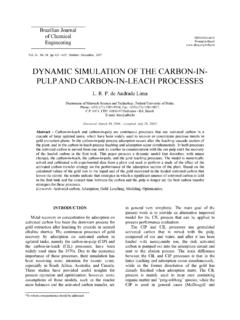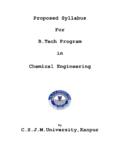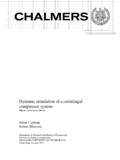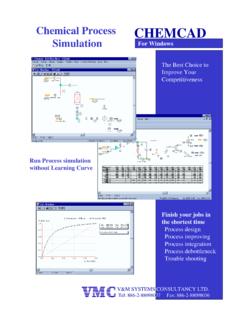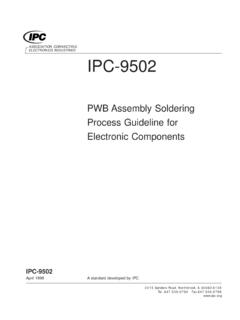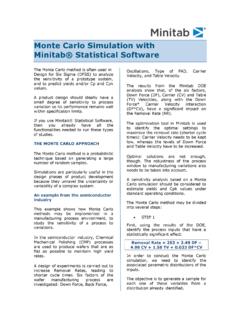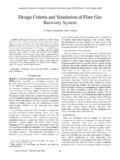Transcription of Hyperquad simulation and speciation (HySS): a utility ...
1 Coordination Chemistry Reviews184 (1999) 311 318 Hyperquad simulation and speciation (HySS): autility program for the investigation ofequilibria involving soluble and partiallysoluble speciesLucia Alderighia, Peter Gansb,*, Andrea Iencoa,Daniel Peters, Antonio Sabatinia, Alberto VaccaaaDipartimento di Chimica,Uni6ersita` degli Studi di Firenze,Via Maragliano77,50144 Firenze and Nazionale delle Ricerche,Via Nardi39,50132 Firenze,ItalybSchool of Chemistry,The Uni6ersity of Leeds,Leeds LS29JT,UKReceived 7 August 1998; accepted 2 November 3111. 3122. Structure of the Hyperquad simulation and speciation (HySS) 3133. 3154. 318 AbstractHyperquad simulation and speciation (HySS) is a computer program written for theWindows operating system on personal computers which provides (a) a system for simulatingtitration curves and (b) a system for providing speciation diagrams.
2 The calculations relateto equilibria in solution and also include the possibility of formation of a partially soluble * Corresponding author. Tel.: 44-113-2336409; fax: (P. Gans)0010-8545:99:$ - see front matter 1999 Elsevier Science All rights :S0010-8545(98) et al.:Coordination Chemistry Re6iews184 (1999) 311 318precipitate. There are no restrictions as to the number of reagents that may be present or thenumber of complexes that may be formed. 1999 Elsevier Science All rights :Solution equilibria ; speciation ; Precipitates1. IntroductionThe calculation of the concentrations of species in chemical equilibrium isimportant in a very wide variety of applications. Two main lines of approach havebeen used. For gas-phase equilibria it is convenient to minimise the free energy ofthe system by adjusting the partial pressures of the reagents, using either stoi-chiometries based on explicit chemical reactions or a nonstoichioimetric approachin which chemical reactions are not used explicitly [1].
3 This follows from the factthat there are extensive databases of standard free energies of formation forcompounds in the gas phase, and the fact that (for ideal-gas mixtures) there is asimple relationship between the chemical potential of a species, its standard freeenergy of formation and its partial pressure (or mol fraction).For equilibria in solution, which we regard as generalised acid base equilibria , itis usual to measure the equilibrium constants for the individual reactions and tocalculate the species concentrations by solving the equations of mass-balance. Thisapproach was pioneered in the programsHALTAFALL[2] andCOMICS[3]. In factHALTAFALL could also handle solid solution and gas solution equilibria and theauthors of that program expounded very clearly the principles involved in all ofthese calculations.
4 However, we note that it has been shown [4] how a set ofstandard free energy data may be obtained from equilibrium constant data, whichcan then be used in a conventional free-energy minimisation algorithm. Suchmethods have been applied to biological systems [5] and to multiphase equilibria [6]. Information on the programEQS4 WIN, which incorporates some of theseextensions, is available at :.Many speciation programs using the equilibrium constant approach have beenwritten. Comparisons of some of them were published first in 1977 [7] and then in1984 [8]. De Robertis et al. [9] have given a good bibliography up to 1986 andanother comparison paper appeared in 1988 [10]. Other programs not cited bythose authors or which were published more recently include:EQUIL[11],RAMESES[12 14],CSMC[15],SYSTAB[16],ESTA[17],INSOL[1 8],CHEMEQL(which runs on anApple MacIntosh and is available at : ) [19]andHYPHEN[20].
5 The motivation for writing a new program was to utilise the facilities offered bythe Windows operating system to provide users with a greater degree of flexibilitythan had been previously possible in respect of both input and output and to makethe program very easy to use. The starting point was our earlier programHYPHEN[20] which handles only equilibria in solution; the present program has the addedoption of including solid solution et al.:Coordination Chemistry Re6iews148 (1999) 311 3182. Structure of the Hyperquad simulation and speciation (HySS) programAt the centre of any calculation the concentrations of the free reagents, [A], [B]etc., are determined by solving the equations of mass-balanceTA [A] %iaibi[A]ai[B] %jpjCjTB [B] %iaibi[A]ai[B] %jqjCjwhereA,B, etc.
6 Are reagents,a,b,..p,q, etc. are stoichiometric indeces,brepresents equilibrium constants and the quantitiesCrepresent molar concentra-tions of insoluble species (quantity of solid divided by the volume of the solution)if any are present. The device of representing the quantity of an insoluble substanceas a concentration was used inHALTAFALL[2]. Associated with each insoluble thereis a solubility [A]pj[B] it is assumed that there is no precipitate present and the free concentrationsare calculated with the C terms omitted from the equations of mass-balance. Ifthere is the possibility of the formation of a precipitate the concentration productis compared with the correspondingKj. If it is larger not only is theCtermincluded, but an additional equation is added to the setlnKj pjln[A] qjln[B].
7 And the free concentrations are recalculated. When a solid is present the set ofmass-balance and solubility equations is solved, according to the Newton Raphsonmethod, by iteratively solving the set of linear equations(TA([A][A](TA([B][B]..(TA( (TB([A][A](TB([B][B]..(TB( ..(lnKj([A][A](lnKj([B][B]..(lnKj( ..Now, because(TA:(TB ((lnKj:([A])[A] pj, etc. the matrix of coefficients issymmetric and we can use the numerically stable [21] Choleski factorisation for thesolution whether or not a precipitate has formed: when a solid has dissolved thecorresponding row and column of the equations will simply be [A][A]D[B][B].. et al.:Coordination Chemistry Re6iews148 (1999) 311 318A further complication can arise in a speciation calculation since it is possible tospecify either the analytical concentration,TA, or the free concentration [A]ofanyreagent.))))))))))))))))))))))
8 For example, the pH may be specified rather thanTH. In that case thecorresponding equation of mass balance is omitted and the given value of that freeconcentration is used to solve the remaining numerical process just outlined is encoded inFORTRAN subroutines compiledto a dynamic link library (DLL). This DLL is called from the program HySS whichis written in 16-bit Visual Basic 4 (VB4). The VB4 code handles all the data inputand output while the DLL performs only numerical processing, thus permitting theuse of the Windows operating system (Windows or Windows95) while retain-ing the speed advantage of compiledFORTRANfor the computationally intensivetask. HySS provides an integrated environment for setting up a calculation,performing it and creating speciation diagrams, etc.
9 There are no limits imposed onthe numbers of reagents, complexes or partially soluble products that may bepresent. Three types of calculation may be performed. (i) simulation of a titrationcurve, (ii) calculation of species concentrations for a range of conditions and (iii) speciation for a single set of conditions (single data points).Data is input by on-screen editing of two forms. The model form allowsequilibrium constants, solubility products and:or stoichiometric coefficients to beentered. This form is common to all three types of calculation. The appearance ofthe conditions form varies a little with circumstances. If the titration simulationoption is chosen, the user enters values for the initial and final volumes and for theconcentrations of reagents in the burette, but if the fixed volume option is chosenonly that volume need be given.
10 The analytical concentration of any reagent maybe set by entering the amount of that reagent initially present in the reaction vesseland in that case calculated initial and final concentrations will be shown on thescreen. Alternatively, in a speciation calculation1the initial and final p[reagent]values may be entered; for example, specifying the initial and final pH will definethe range over which the speciation calculation is to be performed. For single datapoint calculations there is a separate form for entering either the analyticalconcentration of a reagent or the p[reagent] value. Any number of single points canbe entered. All this data will normally be stored in a file. Thus, a complete set ofdata may be entered by recalling it from a file.
